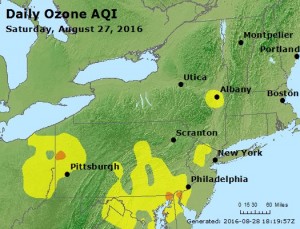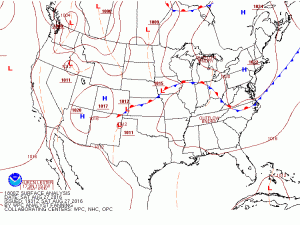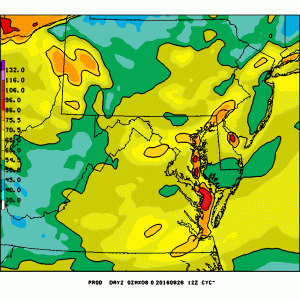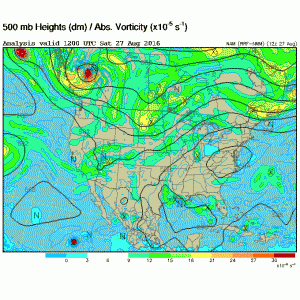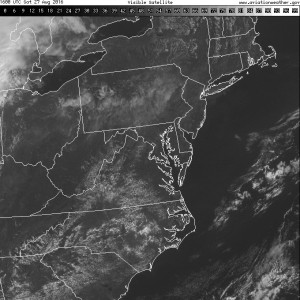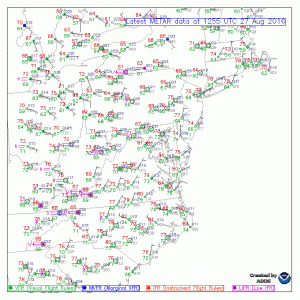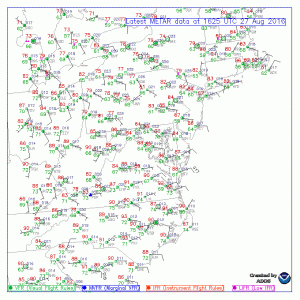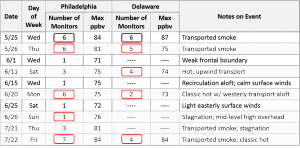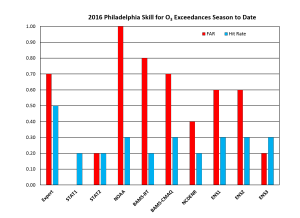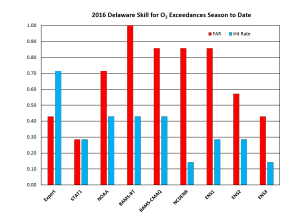Medium Range Air Quality Outlook
Mid-Atlantic Region
Issued: Friday, August 12, 2016
Valid: August 13-17, 2016 (Saturday-Wednesday)


Summary:
Tropical heat and humidity will persist across the Mid-Atlantic through the weekend. The presence of ample regional heat and moisture will support the development of diurnal convection and precipitation over the weekend, though this precipitation is looking more scattered in this morning’s weather forecast models. Periods of afternoon sunshine are possible both Saturday and Sunday before clouds and thunderstorms form, which may support some ozone formation along the I-95 Corridor. However, a fast and clean transport remaining in place aloft should temper rising ozone, keeping the chance for an ozone exceedance Slight through the weekend. A weak cold front is expected to move into the northern Mid-Atlantic on Monday morning and push southward towards the Mason-Dixon Line during the afternoon. Clouds and precipitation are expected to form along and ahead of this front, but locations along I-95 may remain clear though much of the afternoon, allowing for some localized ozone formation. As a result, the chance for an ozone exceedance will rise to Marginal on Monday. This front should stall across the central Mid-Atlantic on Tuesday, but it may move northward as a warm front. The placement of this weak front, combined with the approach an organized line of intense vorticity aloft, will trigger clouds and precipitation across most of the Mid-Atlantic on Tuesday. Once again, there is the possibility for clear skies along I-95, which will keep the chance for an ozone exceedance Marginal for another day. On Wednesday, the potent vorticity streaming aloft will pass directly overhead, acting as a trigger for another round of more widespread cloudiness and precipitation. The chance for an ozone exceedance will drop to Slight on Wednesday as a result.
Discussion:
The weather forecast models are in close agreement regarding the synoptic pattern for the medium range, with differences starting on Monday regarding the placement of a slow-moving cold front. The models consulted for this analysis were the 06Z NAM and GFS and 00Z ECMWF. An upper level trough will progress eastward across southern MB/ON and the northern Plains on Saturday, pulling its associated cold front into the Ohio River Valley. Concurrently, a semi-permanent mid-level ridge centered over the Bermuda High out on the western Atlantic will remain in place on Saturday persist through the medium range. On Sunday, the upper level trough will flatten slightly across the Great Lakes region. The shortwave disturbance which has brought torrential rain to much of the southeast in the past week will get absorbed into the base of the trough, with its energy streaming northeastward into the Mid-Atlantic beginning Sunday evening. At the surface, the cold front will slowly move into the Mid-Atlantic from the northwest and reorient itself east-west, before pushing southward across PA. The upper level trough will pivot northeastward towards New England/Canadian Maritimes on Monday, returning the northern Mid-Atlantic to mostly zonal flow aloft. The GFS and EC differ with their placement of this front, with the GFS placing the front roughly south of the Mason-Dixon Line by 00Z Tuesday. The EC, on the other hand, keeps the front further northward across central PA at this time. WPC stalls the cold front across the central Mid-Atlantic on Tuesday, in the vicinity of the MDL, and keeps it in place through Wednesday. This appears to be a compromise between the GFS and EC solutions, with the GFS keeping the front farther south and the EC farther north. In any case, the front is very diffuse in the 850 mb model guidance. On Tuesday, an upper level shortwave developing across the northern Plains and progressing eastward towards the Great Lakes will invigorate the flattened trough from the weekend. The new upper level trough will slowly move further eastward on Wednesday, with its axis reaching the Ohio River Valley by 00Z Thursday. Additionally, a strong and organized line of vorticity ahead of the trough will push southeastward across the northern and central Mid-Atlantic, triggering precipitation on Wednesday.
Saturday will be yet another oppressively hot and humid day for much of the Mid-Atlantic. The NWS has placed southeastern PA, and essentially the entire states of NJ, DE, and MD under an Excessive Heat Watch for Saturday. Additionally, northern DE, PHL, western NJ and the Newark area remain under an Excessive Heat Warning, which has been extended to Sunday evening. Temperatures will remain well above average, with tropical dew points in the mid-70s °F, resulting in heat indices climbing as high as 110 °F in some locations. This ample heat and moisture across the forecast region will support afternoon convection and thunderstorms, as has been the case the past several days. The GFS brings precipitation to the I-95 Corridor by 18Z, while the NAM and EC do so around 00Z Sunday. The 00Z NMM ARW, 03Z SREF, and 06Z 4 km NAM appear to side with the slower NAM/EC solution. Periods of intense afternoon sunshine before these clouds and precipitation arrive could support some ozone formation along the I-95 Corridor. However, a clean transport pattern will remain aloft. 06Z GFS back trajectories for the I-95 Corridor are fast and southerly, from the NC/SC border, which should act to temper ozone formation across the Mid-Atlantic enough to keep daily average ozone in the Moderate range along the I-95 Corridor. The 06Z air quality models all develop Moderate ozone along and just north of I-95, but they do not resolve any USG ozone across the forecast region. Due to the clean transport pattern in place, the chance for an ozone exceedance will remain Slight on Saturday.
Another round of diurnal thunderstorms is expected across the Mid-Atlantic on Sunday, enhanced by the development of a surface trough ahead of an approaching cold front. As on Saturday, however, the exact placement and extent of this precipitation remains a question, mainly due to the models struggling to resolve the track of the weak front. The NAM keeps the I-95 Corridor dry through 00Z Monday, while the GFS and EC bring scattered precipitation to I-95 by this time. The 03Z SREF still shows a high probability of precipitation near and along the I-95 Corridor Sunday afternoon, however. It is certainly plausible for this approaching front to slow down, as the operational NAM is suggesting, given that the air mass it will be encountering will be especially hot and humid. A second day of at least partly sunny afternoon skies will promote rising ozone once again along the I-95 Corridor. That said, 06Z GFS back trajectories are southwesterly and even faster that on Saturday, originating from northern GA. This clean transport pattern aloft, combined with sustained surface winds, should once again have a moderating effect on rising ozone across the forecast region. The 06Z air quality models are split, likely due to the uncertainty in the precipitation forecast. The BAMS models bring the northern and central Mid-Atlantic down into the Good range on Sunday, while the NCDENR continues to develop a narrow strip line of Moderate ozone along and east of the I-95 Corridor. How high ozone rises on Saturday will give us a sense of which solution is more likely, as well as how fast local ozone production can counteract clean flow aloft. Regardless, the continued clean transport pattern and the possibility of late day thunderstorms will keep the chance for an ozone exceedance Slight on Sunday.
The cold front should move into the northern Mid-Atlantic during Monday morning, before pushing southward during the afternoon. As discussed above, there is uncertainty regarding the placement of this front by the end of Monday. The GFS brings it further southward into VA by 00Z, while the EC keeps it across central/southern PA through this time. 06Z GFS back trajectories for the I-95 Corridor shift westerly and are localized at 500m, suggesting that the front will still be north of PHL by 12Z. Clouds and scattered precipitation are expected to form both along and ahead of this front. Locations behind the front will experience post-frontal clearing and a shift to northwesterly surface winds. These winds will be light, however, so the presumably cleaner and slightly cooler/drier air mass behind the front will likely be slow to build in. Locations that remain ahead of the front will remain under the influence of a potentially modified air mass. If clouds and precipitation are not as widespread as expected, converging winds along the front could cause locally enhanced ozone formation. The BAMS models are showing hints of this, with a line of Moderate ozone across the central Mid-Atlantic, with small patches of USG ozone resolved near PIT and DC. This seems slightly overdone, however, given the support for at least scattered cloud cover and precipitation along the front. Given the uncertainty associated with the track and impacts of the front, the chance for an ozone exceedance on Monday will rise to Marginal.
On Tuesday, the cold front is expected to stall across the central Mid-Atlantic, in the vicinity of the Mason-Dixon Line. The placement of this front, combined with intense upper level vorticity approaching the forecast region, should support more widespread afternoon clouds and precipitation, with both the GFS and EC developing precipitation across almost the entire Mid-Atlantic by 00Z Wednesday, although the GFS keeps the I-95 Corridor clear for much of the afternoon. 06Z GFS back trajectories for the I-95 Corridor shift northwesterly behind the front, but they are relatively slow. This presumably clean northwesterly flow both aloft and at the surface, along with ample diurnal precipitation, should limit ozone formation across most of the Mid-Atlantic. If the GFS’s afternoon sunshine along I-95 verifies, however, there may be opportunity for localized ozone formation, given high pressure building in from the north, light surface winds, and still very warm conditions. The BAMS models develop Moderate ozone all along and west of the I-95 Corridor and resolve areas of USG ozone over PHL and southern NJ. Once again, this seems entirely overdone, given the limiting factors in place expected to be in place on Tuesday. But given the uncertainty in the precipitation forecast, the chance for an ozone exceedance will remain Marginal on Tuesday, primarily for the I-95 Corridor.
The WPC keeps the stalled front across the central Mid-Atlantic on Wednesday, but as discussed above, it may be north or south of the MDL, depending on which model solution verifies. The intense vorticity streaming aloft will pass directly over the northern and central Mid-Atlantic, providing a trigger for another round of widespread clouds and precipitation throughout the forecast region during the afternoon. 06Z GFS back trajectories for the I-95 Corridor become southerly again in response to the strengthening of the Bermuda High/subtropical ridge. This will reinforce the likelihood of Good air quality across the region, given the presence of regional cloudiness and precipitation. Therefore, the chance for an ozone exceedance will drop to Slight for Wednesday.
-Brown/Huff
